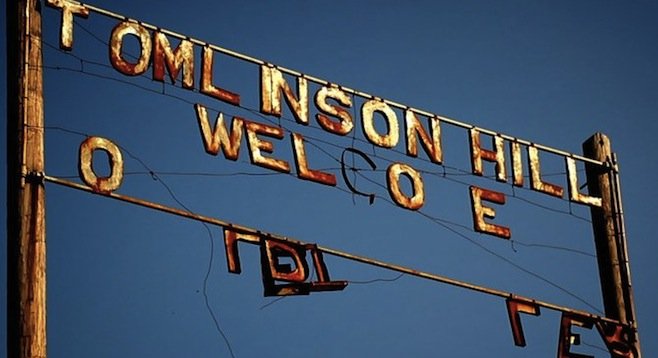 Facebook
Facebook
 X
X
 Instagram
Instagram
 TikTok
TikTok
 Youtube
Youtube

Tomlinson is a famous name in San Diego, thanks to the family's most noted member, former Chargers running back LaDainian Tomlinson. It's the same in Texas, but these days another who bears the Tomlinson name is getting attention for a book he's written about the Tomlinson family history.

The author of Tomlinson Hill: The Remarkable Story of Two Families Who Share the Tomlinson Name — One White, One Black, is Chris Tomlinson, an Austin journalist who had long been curious about his family's slave-owning past on the plantation they once owned along the Brazos River.
"My great-grandfather bought the Hill in 1856, grew cotton, and owned slaves," writes Tomlinson, a fifth-generation Texan who authors a twice-weekly column for the Houston Chronicle.
"Yet my father never took me there. I was told it was just a boring open field, with a picnic pavilion for Memorial Day barbecues and family reunions. My parents never went to those reunions, but other Tomlinsons did."
As Tomlinson describes it, by the time he was born, his branch of the family had little left but memories.
"My father, Bob Tomlinson, co-owned a bowling supply shop with his father. We didn't have much money, and Dad spent his evenings and weekends in bowling alleys.
"When he was home, my parents fought, usually about money and often about my father's lack of ambition. He was overweight, wore his hair long, and had a 1970s mustache.
“He wore garish shirts and high-heeled boots and listened to jazz on Sunday mornings in his bathrobe. He believed in corporal punishment, usually administered with a belt."
Then Tomlinson came across an old family scrapbook. "The obituaries and anniversary notices mentioned Tomlinson Hill but provided no details.
“When I asked about it, relatives provided me with only one fact about the old slave plantation: When emancipation came, the former slaves had taken our name as their own. There were black Tomlinsons, too."
"I tried to imagine the black Tomlinsons. Could their family have moved to Dallas, too? Were they still in the country? What an irony that would be. I had always imagined blacks to be urban and the countryside to be white."
Chris Tomlinson grew up to be reporter and went to Afghanistan to cover the war for the Associated Press.

"On Dec. 15, 2001, I was sitting in the sun with Afghan warlords while they used a walkie-talkie to negotiate the surrender of al-Qaeda fighters, who were decimated and demoralized by American air power. LaDainian was in Qualcomm Stadium in San Diego, being pummeled by the Oakland Raiders in a game that would end with a 6-13 loss for the Chargers."
"My father first told me about LaDainian in 1999 and guessed he must be a descendant of the Tomlinson Hill slaves. He was right. LaDainian had spent summers with his grandparents, playing in the fields where his great-grandfather had been a slave and picked cotton."
Chris Tomlinson eventually came to know LaDainian Tomlinson, who wrote the book's forward.
“My father, Oliver Terry Tomlinson, used to tell me that Tomlinson Hill got its name from our family, because that’s where our family originated from and it was where we had always been," LaDainian says. "That made me proud, because the Hill had my name on it. It was our place.
“My father, though, was just being protective of us, trying to shelter us from a tough world with a brutal history.”
Despite his fame and money, life has not always gone smoothly for LaDainian’s family. As reported here in January 2004, his mother Loreane declared bankruptcy in 2002 amid troubled investments.
“The business was begun some 14 months ago with $100,000 given to [her] by her son.... Only $759.69 still remains of the original $100,000 investment,” according to court records. "The financial documents reviewed and the testimony of the debtors indicate the business will not be successful.”
LaDainian has reportedly returned to Texas to live, and recently sold his lavish Poway estate for $3.495 million, considerably less than he invested in it.
In 2011, the property was listed at $5.21 million.


Tomlinson is a famous name in San Diego, thanks to the family's most noted member, former Chargers running back LaDainian Tomlinson. It's the same in Texas, but these days another who bears the Tomlinson name is getting attention for a book he's written about the Tomlinson family history.

The author of Tomlinson Hill: The Remarkable Story of Two Families Who Share the Tomlinson Name — One White, One Black, is Chris Tomlinson, an Austin journalist who had long been curious about his family's slave-owning past on the plantation they once owned along the Brazos River.
"My great-grandfather bought the Hill in 1856, grew cotton, and owned slaves," writes Tomlinson, a fifth-generation Texan who authors a twice-weekly column for the Houston Chronicle.
"Yet my father never took me there. I was told it was just a boring open field, with a picnic pavilion for Memorial Day barbecues and family reunions. My parents never went to those reunions, but other Tomlinsons did."
As Tomlinson describes it, by the time he was born, his branch of the family had little left but memories.
"My father, Bob Tomlinson, co-owned a bowling supply shop with his father. We didn't have much money, and Dad spent his evenings and weekends in bowling alleys.
"When he was home, my parents fought, usually about money and often about my father's lack of ambition. He was overweight, wore his hair long, and had a 1970s mustache.
“He wore garish shirts and high-heeled boots and listened to jazz on Sunday mornings in his bathrobe. He believed in corporal punishment, usually administered with a belt."
Then Tomlinson came across an old family scrapbook. "The obituaries and anniversary notices mentioned Tomlinson Hill but provided no details.
“When I asked about it, relatives provided me with only one fact about the old slave plantation: When emancipation came, the former slaves had taken our name as their own. There were black Tomlinsons, too."
"I tried to imagine the black Tomlinsons. Could their family have moved to Dallas, too? Were they still in the country? What an irony that would be. I had always imagined blacks to be urban and the countryside to be white."
Chris Tomlinson grew up to be reporter and went to Afghanistan to cover the war for the Associated Press.

"On Dec. 15, 2001, I was sitting in the sun with Afghan warlords while they used a walkie-talkie to negotiate the surrender of al-Qaeda fighters, who were decimated and demoralized by American air power. LaDainian was in Qualcomm Stadium in San Diego, being pummeled by the Oakland Raiders in a game that would end with a 6-13 loss for the Chargers."
"My father first told me about LaDainian in 1999 and guessed he must be a descendant of the Tomlinson Hill slaves. He was right. LaDainian had spent summers with his grandparents, playing in the fields where his great-grandfather had been a slave and picked cotton."
Chris Tomlinson eventually came to know LaDainian Tomlinson, who wrote the book's forward.
“My father, Oliver Terry Tomlinson, used to tell me that Tomlinson Hill got its name from our family, because that’s where our family originated from and it was where we had always been," LaDainian says. "That made me proud, because the Hill had my name on it. It was our place.
“My father, though, was just being protective of us, trying to shelter us from a tough world with a brutal history.”
Despite his fame and money, life has not always gone smoothly for LaDainian’s family. As reported here in January 2004, his mother Loreane declared bankruptcy in 2002 amid troubled investments.
“The business was begun some 14 months ago with $100,000 given to [her] by her son.... Only $759.69 still remains of the original $100,000 investment,” according to court records. "The financial documents reviewed and the testimony of the debtors indicate the business will not be successful.”
LaDainian has reportedly returned to Texas to live, and recently sold his lavish Poway estate for $3.495 million, considerably less than he invested in it.
In 2011, the property was listed at $5.21 million.
Comments